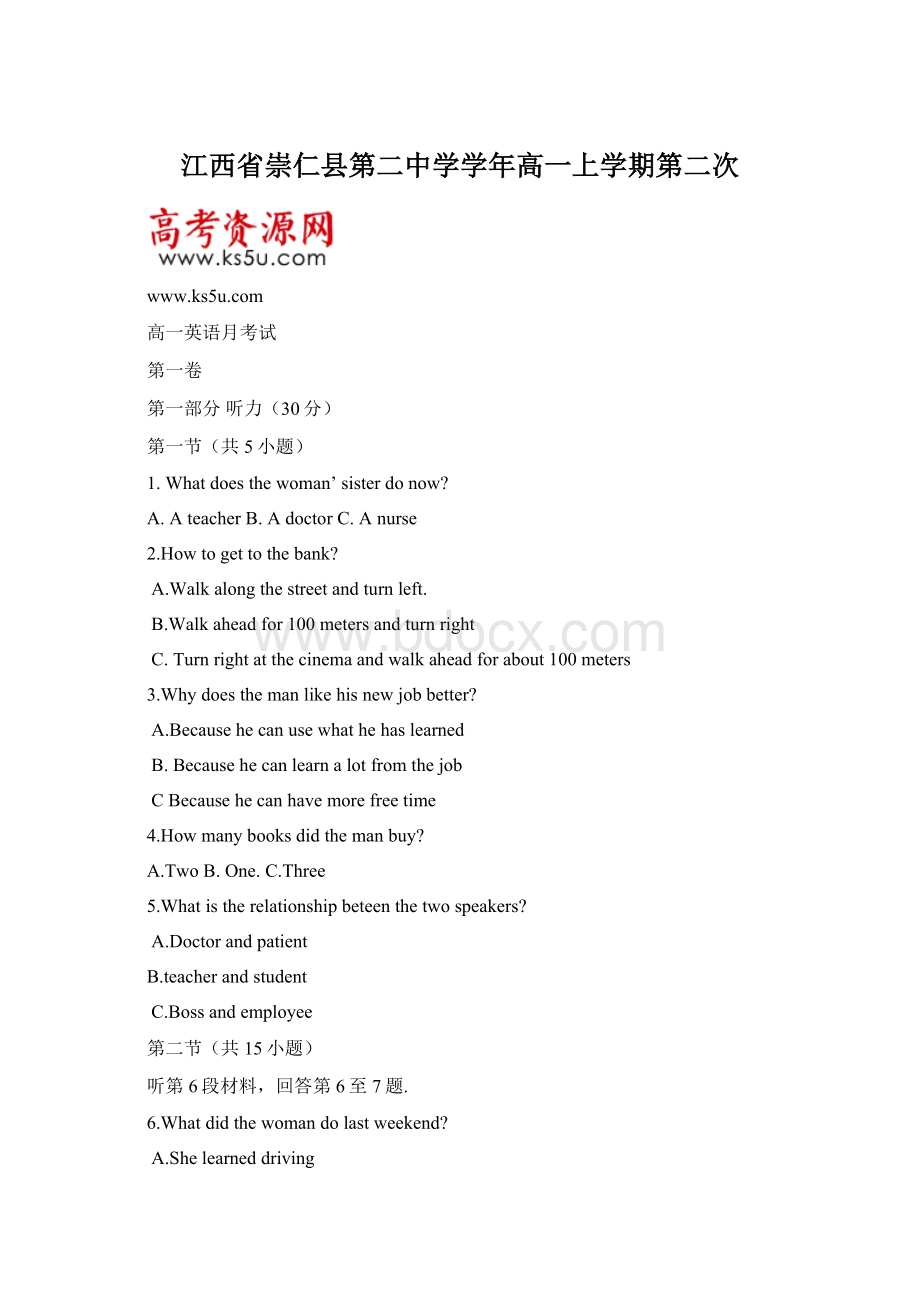江西省崇仁县第二中学学年高一上学期第二次.docx
《江西省崇仁县第二中学学年高一上学期第二次.docx》由会员分享,可在线阅读,更多相关《江西省崇仁县第二中学学年高一上学期第二次.docx(25页珍藏版)》请在冰豆网上搜索。

江西省崇仁县第二中学学年高一上学期第二次
高一英语月考试
第一卷
第一部分听力(30分)
第一节(共5小题)
1.Whatdoesthewoman’sisterdonow?
A.AteacherB.AdoctorC.Anurse
2.Howtogettothebank?
A.Walkalongthestreetandturnleft.
B.Walkaheadfor100metersandturnright
C.Turnrightatthecinemaandwalkaheadforabout100meters
3.Whydoesthemanlikehisnewjobbetter?
A.Becausehecanusewhathehaslearned
B.Becausehecanlearnalotfromthejob
CBecausehecanhavemorefreetime
4.Howmanybooksdidthemanbuy?
A.TwoB.One.C.Three
5.Whatistherelationshipbeteenthetwospeakers?
A.Doctorandpatient
B.teacherandstudent
C.Bossandemployee
第二节(共15小题)
听第6段材料,回答第6至7题.
6.Whatdidthewomandolastweekend?
A.Shelearneddriving
B.Sherepairedhercar
C.Shehadapicnic.
7.Whatcanweknowabouttheman?
A.Hehasanewcar
B.Hewanttobuyanewcar
C.Heoftenrepairshiscarontheweekend
听第7段材料,回答第8至9题.
8.Whatdoesthemantobuy?
A.Abirthdaycake
B.Abirthdaypresent
C.Anexpensivecoat
9.Whichcolordoesn’tthewomanlike?
A.YellowB.RedC.Blue
听第8段材料,回答第10至12题.
10.Whatkindofcomputerdoesthemanwanttobuy?
A.Acheapimportedcomputer
B.Anexpensiveimportedcomputer
C.AcomputermadeinChinaatanacceptableprice.
11.Howmuchwillthemanpayforthecomputerforthefirsttime?
A.5,000yuanB.3,000yuanC.1,000yuan
12.Whatdoesthemanaskthewomantodoatlast?
A.Workoutthedetails
B.Givehimsomeadvice
C.Showhimanothercomputer
听第9段材料,回答第13至16题.
13.Wheredidthewomanlearnaboutthejob/
A.inthenewspaperB.OntheradioC.OnTV
14.Atleasthowmanyhourswillthewomanhavetoworkeveryday?
A.ThreehoursB.RourhoursC.Fivehours
15.Whatcanweknowaboutthejob?
A.Thesalaryis300poundspermonthatmost
B.Workinghoursisfrom2amto10ameveryday
C.It’sapart-timejob,andthesalaryis75poundsaweekatleast.
16.Whendoesthemantohaveatalkwiththewoman?
A.NextWednesdaymorning
B.NextWednesdayafternoon
C.NextWednesdayevening.
听第10段材料,回答第17至20题.
17.WhatthemainprobleminAsia?
A.Thesmallnumberofnewbornbabies
B.Thechangingsocialsituatinofwomen
C.Thehighpriceofhoursandeducation.
18.Howmuchatleastdoesachild’kindergartenchargeamonthin
amajiorAsiancity?
A.$25,000B.$5,000C.$416.
19.Whydomoreandmoremarriedwomenrefusetohaveachildren?
A.Theycan’tkeeptheirjobs.
B.Theyarelookeddownupon
C.theyhavetobringuptheirchildren.
20.Whatcanwelearnfromthespeaker’talk?
A.It’easyforacoupletoaffordachildinAsia.
B.Itwillcostparentstoomuchtoaffordtheirkids’education.
C.thepricesofhousesinmangmajorAsiancitiesarequitelownow.
第二部分阅读理解(共20小题,每小题2分;共40分)
A
ThePalaceMuseum,knownastheForbiddenCity,wastheimperial(帝王的)palaceoftheMingandQingDynasties.Intheearly15thcentury,large-sizeconstructioncaused100,000commonpeopletoleadahardlife.Theconstructiontook14yearsandwasfinishedin1420.Inthefollowingyear,thecapitalofMingDynastywasmovedfromNanjingtoBeijing.Twenty-fouremperorsoftheMingandQingDynastiesruledfromtheForbiddenCity.Thelastdynastyfellin1911,butEmperorPuyistilllivedintheinnercourt.Itwasnotuntil1925thatthecomplexbuildingswerechangedintoamuseum.Sincethen,thePalacehasbeenopenedtothepublic.
ThePalaceMuseumisrectangular(长方形的)inshape,about960meterslongfromnorthtosouthand750meterswidefromwesttoeast.Thereisa10-meter-highwall,encircledbya52-meter-widemoat(护城河).IntheMingDynasty,thewoodneededforthebuildingwasbroughtmostlyfromSichuanandHunanProvince,whileintheQingDynasty,itwascutfromthenortheastofChina.Mostofthestoneswereminedfromthesuburban(郊外的)districtofFangshanandotherdistricts.ConstructionoftheForbiddenCitybroughthugehardshiptothelaboringpeople.
ThepalaceisthelargestpieceofancientChinesearchitecture(建筑)stillstanding.SomeofthebuildingsweredamagedbylightningandrebuiltintheMingandQingDynasties.Thepalacehasbeenexpandedseveraltimes,buttheoriginaldesignwaspreserved.Afterliberation,somecostlyrenovations(翻新)weredoneandthePalaceMuseumislistedasoneoftheimportanthistoricalsitesunderspecialpreservationbytheChinesegovernment.
21.TheForbiddenCityisalsocalled .
A.theHistoryMuseumB.thePeople'sSite
C.thePalaceMuseumD.theSummerPalace
22.TheForbiddenCitybegantobeconstructedin
A.1911B.1421C.1406D.1420
23.WhatcanwelearnfromParagraph2?
A.Theemperors'crueltybroughttheForbiddenCityintotheworld.
B.TheprocessingofconstructingtheForbiddenCityneededwoodandstonesfromalloverthecountry.
C.TheForbiddenCityisthelargestpieceofancientChinesearchitecturestillstanding.
D.TheForbiddenCityisabout720,000squaremeters.
24.Thispassagemostprobablycomesfromabookon .
A.customsandhabitsB.dynastiesandemperors
C.historyandemperorsD.architectureandhistory
B
Candogsandcatsliveinpeaceinthesamehome?
Peoplewhoarethinkingaboutadoptingadogasafriendfortheircatareworriedthattheywillfight.Arecentresearchhasfoundanewwayforsuccess.Accordingtothestudy,ifthecatisadoptedbeforethedog,andiftheyareintroducedwhenstillyoung(lessthan6monthsforcats,ayearfordogs),itishighlyprobablethatthetwopetswillgetalongswimmingly.Twothirdsofthehomesinterviewedreportedapositiverelationshipbetweentheircatanddog.
However,itwasn'tallsweetnessandlight.Therewasareportedcoldnessbetweenthecatanddogin25%ofthehomes,whileattackingandfightingwereobservedin10%ofthehomes.Onereasonforthisisprobablythatsomeoftheirbodysignalsarejustopposite.Forexample,whenacatturnsitsheadawayitsignalsattack,whileadogdoingthesamesignalsadmittingdefeat.
Inhomeswithcatsanddogslivingpeacefully,researchersobservedasurprisingbehaviour.Theyarelearninghowtotalkeachother'slanguage.Itisasurprisethatcatscanlearnhowtotalk“dog”,anddogscanlearnhowtotalk“cat”.
What'sinterestingisthatbothcatsanddogshaveappearedtodeveloptheirintelligence.Theycanlearntoreadeachother'sbodysignals,suggestingthatthetwomayhavemoreincommonthanwaspreviouslythought.Oncefamiliarwitheachother'spresenceandbodylanguage,catsanddogscanplaytogether,greeteachothernosetonose,andenjoysleepingtogetheronthesofa.Theycaneasilysharethesamewaterbowlandinsomecasesgroom(梳理)eachother.
Theadvantageofthisresearchoncatsanddogsmaynotonlyaboutpets—topeoplewhodon'tgetalong,includingneighbours,colleaguesatwork,andevenworldsuperpowers.Ifcatsanddogscanlearntogetalong,surelypeoplehaveagoodchance.
25.Theunderlinedword“swimmingly”inParagraph1isclosestinmeaningto________.
A.earlyB.sweetly
C.quicklyD.surprisingly
26.Somecatsanddogsmayfightwhen________.
A.theyarecoldtoeachother
B.theylookawayfromeachother
C.theyunderstandeachother'ssignalsinawrongway
D.theyareintroducedatanearlyage
27.Whatisfoundsurprisingaboutcatsanddogs?
A.Theyeatandsleeptogether.
B.Theyobserveeachother'sbehaviors.
C.Theylearntospeakeachother'slanguage.
D.Theyknowsomethingfromeachother'svoices.
28.Whatcanwehumanbeingslearnfromcatsanddogs?
A.Weshouldlearntoliveinpeace.
B.Weshouldknowmoreaboutanimals.
C.Weshouldliveinpeacewithanimals.
D.Weshouldlearnmorebodylanguages.
C
Here’ssomethingtothinkaboutthenexttimeyouaskyourteacherforhelp:
doschoolworkonyourowncanhelpyoulearn.Accordingtoarecentstudy,themoreyoustruggle(努力)whileyouarelearningnewinformation,thebetteryoucanrememberitlater.
Itmightsurpriseyou.Whenteachersarepresentingnewinformation,theyoftengivestudentslotsofhelp.Butanewstudyshowsthismaynotbethebestwaytosupportlearning.“Don’tbetooquicktogethelpwhenlearningsomethingnew,”educationexpertManuKapursaid.“Trytoworkonityourselfevenifitmeanstryingdifferentways.”
Kapurcameupwiththeideathatstrugglingcanleadtobetterlearning.ThenhetesteditoutonstudentsinSingapore.Heseparatedstudentsintotwogroups.Inthefirstgroup,studentswereaskedtosolvemathproblemswiththeteacher’shelp.Inthesecondgroup,studentswereaskedtosolvethesameproblemsbyhelpingoneanotherinsteadofgettinghelpfromtheteacher.
Withtheteacher’shelp,studentsinthefirstgroupwereabletofindthecorrectanswers.Studentsinthesecondgroupdidnotsolvetheproblemscorrectly,buttheydidcomeupwithalotofgoodideas.
Thestudentswerethentestedonwhattheyhadlearned.Thegroupwithoutanyhelpfromateacherscoredmuchhigherthanthegroupwhohadhelp.Kapursaidworkingtofindtheanswershelpedstudentsunderstandtheprocess(过程),notjustthesolution.
Kapur’sadviceforkidsistoputalotofeffortintolearningsomethingnewratherthangoingtoyourteacherforhelp.“Simplydoingalittleworkornothingatallwon’twork,”saysKapur.“Thestruggleneedstobearealattempttofigureout(想出)orsolveaprobleminasmanywaysaspossible.”
29.Whichofthefollowingisthebestwaytolearnaccordingtothepassage?
A.Figuresomethingoutonyourown.
B.Askteachersforhelpintime.
C.Begiventhesolutiontotheproblem.
D.Paylittleattentiontotheprocess.
30.Kapursupportedhisideaby.
A.showingcausesB.describinganactivity
C.makingatestD.i